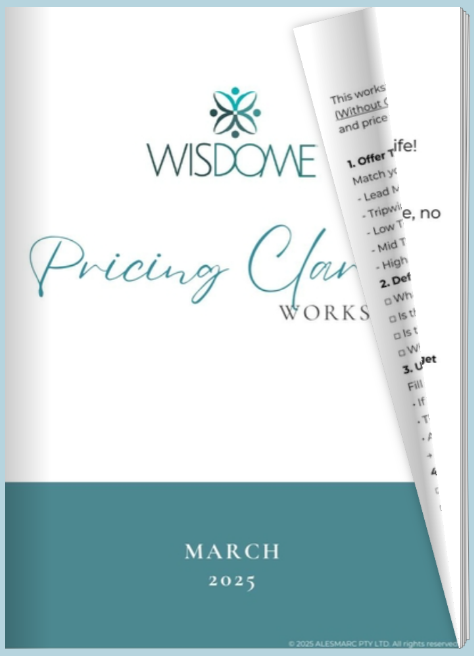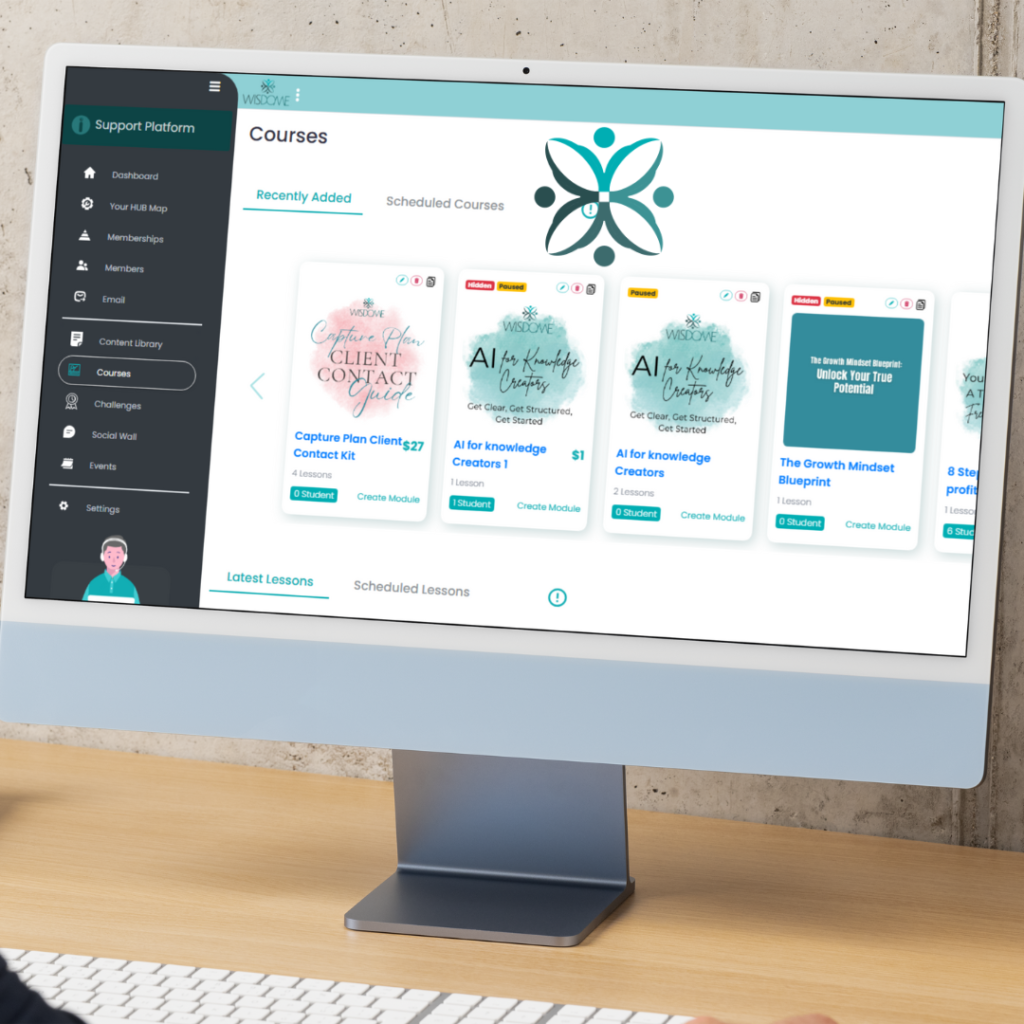So you’ve done the hardest part of structuring your online course or coaching program. But now you’ve hit that all-too-familiar roadblock: pricing. As a knowledge sharer, you know pricing matters. Set it too low, and people might question its value. Set it too high, and you risk scaring off potential buyers.
If you’re feeling stuck or second-guessing every number you write down, let me tell you this happens to all of us.
Don’t worry. You’re in good company. By the end of this post, you’ll have a clear framework to price your offers with confidence and clarity. Let’s begin.
The Pricing Dilemma for Knowledge Sharers: Why It Can Be Overwhelming
Pricing is more of a mental game than it is about crunching numbers. For many knowledge sharers, pricing an offer evokes hidden fears like, ‘Am I worth it? ’ or ‘What if people think I’m charging too much? ’
This happens to all of us. We can completely freeze at the thought of giving a price tag to our offer. There’s one thing I want you to remember: as long as you can deliver real transformation, you don’t have to let confusion hold you back from pricing your courses or coaching programs with confidence.
Takeaway: Pricing is more of an emotional decision than a logical number game. Stay clear on the value you bring to the table so you can price your offer in a way that feels right.
Catch the video version of this article! 🎥 Watch it now!
Understanding the Key Pricing Terms for Knowledge Sharers (Without the Confusion)
Let’s break down important terms used when building your offer so you can feel confident in the structure and value of your offer.
Lead Magnet
Lead magnets are created as a freebie. It could be a quiz, a PDF, or a checklist. Lead magnets should grab your audience’s attention. It’s like saying, ‘Hey, I’m here, and I’ve got something valuable just for you.’
Important Tip:
When creating your freebie, don’t give away everything at once. Instead, offer insight into a specific pain point, something that sparks curiosity and trust, without leaving them feeling like they’ve already downloaded your entire course for free.
Why?
Well, here’s the thing…
We naturally place more value on things we’ve paid for, while freebies often get tossed to the back of our minds and forgotten.
The second reason? Dumping all your strategies into one sitting can be overwhelming. It ends up being too much and too fast. Your message could be lost in all the noise. What feels simple to you (because you live and breathe it) can feel like a tidal wave of information to someone hearing it for the first time.
That’s why it’s better to package your knowledge into a mini course or program that can support your audience’s learning journey. Guide them through it at their own pace, without feeling overwhelmed.
Tripwire / Tiny Offer
Think of a $7–$47 offer that moves someone to buy something from you. This is called a tripwire: something that’s low-risk but high-impact and builds trust fast. Think of it as a little taste of what you offer, like a mini-course, a checklist, or a quick win that solves a very specific problem.
Tip:
When creating a tiny offer, ensure it delivers genuinely valuable information, but don’t overthink it. It doesn’t need to be perfect or packed with hours of content. What matters most is that it solves one clear problem well and leaves your buyer thinking, ‘Wow, if this is what they give at this price, imagine the value in their bigger offers! ’
Low-Ticket Offer
Typically, this is a product or service priced between $50–$100. This is your stepping stone for buyers. For example, you can offer a mini-course, a bundle of tools, or a recorded masterclass. It’s a way to give your audience a flavour of your work without a massive commitment. These low-priced offers also help build your email list.
Mid-Tier/Signature Program
Self-paced offers along with some live events and challenges are considered mid-tier signature programs. They’re usually priced from $200–$700. This is where you really get to show up as the expert they can rely on.
High-Ticket Offer
Understanding the different tiers of your offerings is essential when deciding on your pricing strategy. You can offer premium services such as one-on-one coaching, VIP days, or comprehensive group programs. These types of offerings are typically priced above $1,000 and provide clients with exclusive, personalised support.
What sets these high-value programs apart is the depth of engagement and the ongoing assistance you provide. Clients who invest in these programs are committed to transformative results. They know that their journey requires sustained guidance, and they trust you to guide them through that process.
These high-ticket offerings often include elements such as regular check-ins, personalised action plans, and continuous accountability. This ensures that clients keep moving forward all while feeling supported at every stage of the journey.
Key Insight: Differentiating these various price points helps align your offers with the needs and expectations of your clients. Start with smaller, more accessible offerings and scale upwards over time.
The 4-Step Pricing Framework for Knowledge Sharers
Now, we’re ready for the good stuff. Let’s explore the 4-step framework that will take the guesswork out of pricing your courses and coaching programs.
#1: Define What You’re Selling
First things first, what outcome will your clients get from your program? Is your offer focused on a quick win or a complete transformation? If it’s a smaller, short-term result, don’t overcharge for it. Think of it as your entry point to serving new clients or a wider audience.
On the other hand, if your offer delivers a huge transformation, you can charge more. You’re guiding someone through a lasting change, and naturally, this kind of program will take more time, energy, and commitment. It’s only fair and appropriate to price it accordingly.
Also, think about how much personal interaction you’re providing. Is it self-paced? Are you coaching them through it? If so, how often are you checking in, giving feedback, or offering support in real time? Your pricing should reflect the depth and consistency of the experience you’re delivering.
Takeaway: Your price needs to align with the real value of what you’re offering.
#2: The Anchor Method for Pricing Your Knowledge
What would you charge if you were doing a one-on-one coaching session? What’s the price that feels too low for you to take seriously? And what price makes you a little nervous but still proud? That’s where you want to be. The sweet spot is between what you feel comfortable with and what makes you consider the value of your insights.
Take away: Pricing is about balance. Consider what feels good and what feels a little scary for you. Trust yourself to find that middle ground.
#3: Think Like a Buyer
Customers who buy from you are looking for value and transformation. They’re placing their hope, trust, and energy into the promise that something in their life or business will improve. This is where pricing becomes emotional as much as it is strategic.
Here’s the emotional side of pricing:
- Under $50: ‘Why not? It’s affordable enough to take a chance.’
- $100–$500: ‘Okay, this is a real investment. I hope it delivers’.
- Over $1,000: ‘Is this truly worth it? Will I walk away changed, better, and equipped? ’
Takeaway:
Pricing is about more than just numbers; it’s built on perception and trust. Your offer has to reflect the value it creates for your clients. When your price is neither inflated nor undervalued, it reassures your audience that they’re making a smart investment.
Conclusion: Pricing Your Knowledge with Confidence
Pricing doesn’t have to make you feel stuck.
In fact, it works best when it’s straightforward and grounded in your intention. People will buy from you because of the outcomes, identity, and belonging you can help them achieve.
Your price sends a signal. It tells your audience what to expect from you and your program.
Underprice yourself, and people question the value. Overprice without context, and they hesitate. But when your pricing matches the change you’re offering people will lean into it.
So price your program in a way that reflects the impact it creates.

Want to get it right?
Download the free pricing framework and apply it to your business today.
Grab Your Copy Here: Your Pricing Clarity Workbook

P.S. If you’re ready to turn your knowledge into a thriving business, a course, a coaching offer, or a membership, join the Eff-Ex program. You’ll get expert guidance and 12 months of free access to Wisdome so you can sell your content and scale confidently.
Learn how to:
- Structure your offer
- Create effective marketing campaigns
- Launch your course, coaching program, or memberships
- And more…







